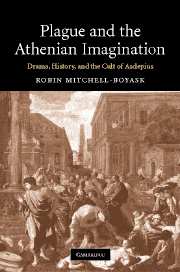Book contents
- Frontmatter
- Contents
- Preface
- Prologue
- Figure 1
- Chapter 1 Introduction
- Chapter 2 Death, myth and drama before the plague
- Chapter 3 Materials I: The language of disease in tragedy
- Chapter 4 Plague, cult and drama: Euripides' Hippolytus
- Chapter 5 Oedipus and the plague
- Chapter 6 The Trachiniae and the plague
- Chapter 7 Materials II: The cult of Asclepius and the Theater of Dionysus
- Chapter 8 Disease and stasis in Euripidean drama: Tragic pharmacology on the south slope of the Acropolis
- Chapter 9 The Athenian Asklepieion and the end of the Philoctetes
- Chapter 10 Conclusions and afterthoughts
- Works Cited
- Index
Chapter 10 - Conclusions and afterthoughts
Published online by Cambridge University Press: 22 September 2009
- Frontmatter
- Contents
- Preface
- Prologue
- Figure 1
- Chapter 1 Introduction
- Chapter 2 Death, myth and drama before the plague
- Chapter 3 Materials I: The language of disease in tragedy
- Chapter 4 Plague, cult and drama: Euripides' Hippolytus
- Chapter 5 Oedipus and the plague
- Chapter 6 The Trachiniae and the plague
- Chapter 7 Materials II: The cult of Asclepius and the Theater of Dionysus
- Chapter 8 Disease and stasis in Euripidean drama: Tragic pharmacology on the south slope of the Acropolis
- Chapter 9 The Athenian Asklepieion and the end of the Philoctetes
- Chapter 10 Conclusions and afterthoughts
- Works Cited
- Index
Summary
Here I shall close with some general considerations about Athenian drama and society toward the end of the fifth century BCE. In this study, I have not sought even to imply that the readings presented here exclude all others or that Asclepius is the only key to understanding Greek drama, which is as complex an art form and, in Kenneth Burke's terms, a social action as any seen in the history of Western literature. I have, however, tried to ask a different set of related questions about tragedy in Athens than has normally been the practice among scholars in this field. What happens if we take nosological imagery and language seriously, and consistently so? Why does this imagery seem to increase in frequency after the plague at Athens and especially after the construction of the City Asklepieion on the south slope of the Athenian Acropolis, at the upper western edge of the Theater of Dionysus? What significance does the appearance of Asclepius and related themes have in tragedy? Why do Asclepius temples sit so often next to theaters? Do questions about disease imagery in Athenian drama give rise to new resonances and interpretive possibilities after the plague and the construction of the Asklepieion? These familial questions are part of a complex system of meaning generated from the conditions of performance. In Athens during and after the plague poets drew on traditional associations of healing and music to suggest a balm for the troubled audience.
- Type
- Chapter
- Information
- Plague and the Athenian ImaginationDrama, History, and the Cult of Asclepius, pp. 183 - 191Publisher: Cambridge University PressPrint publication year: 2007



